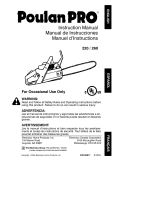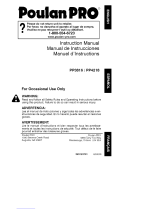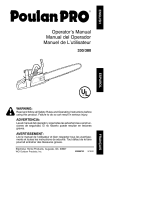
17
U.S. EPA/CALIFORNIA/ENVIRONMENT CANADA
EMISSION CONTROL WARRANTY STATEMENT
YOUR WARRANTY RIGHTS AND OB-
LIGATIONS: The U.S. Environmental
Protection Agency, California Air Resources
Board, Environment Canada and POULAN/
WEED EATER. DIVISION OF WCI OUT-
DOOR PRODUCTS, INC., are pleased to
explain the emissions control system war-
ranty onyour year2000--2003 smalloff--road
engine. In California, all new small off--road
engines must be designed, built, and
equipped to meet the State’s stringent anti--
smog standards. POULAN/WEED EATER
mustwarrant the emissioncontrol systemon
your small off--road engine for the periods of
time listed below provided there has been no
abuse, neglect, or improper maintenance of
your small off--road engine engine. Your
emission control systemincludes parts such
as the carburetor and the ignition system.
Where a warrantable condition exists, POU-
LAN/WEED EATER will repair your small
off--road engine engine atno cost to you. Ex-
penses covered under warranty include
diagnosis, parts andlabor. MANUFACTUR-
ER’S WARRANTY COVERAGE: If any
emissions related part on your engine (as
listed under Emissions Control Warranty
Parts List) is defective or a defect in the ma-
terials or workmanship of the engine causes
the failure of such an emission related part,
the part will berepaired orreplaced by POU-
LAN/WEED EATER. OWNER’S WAR-
RANTY RESPONSIBILITIES: As the small
off--road engine engine owner, you are re-
sponsible for the performance of the re-
quired maintenance listed in your instruction
manual. POULAN/WEED EATER recom-
mends that you retain all receipts covering
maintenance on your small off--road engine,
but POULAN/WEED EATER cannot deny
warranty solely for the lack of receipts or for
your failure to ensure the performance of all
scheduled maintenance. As the small off--
road engine engine owner, you should be
aware that POULAN/WEED EATER may
deny you warranty coverage if your small
off--road engine engine or a part of it has
failed due to abuse, neglect, improper main-
tenance, unapproved modifications, or the
use of parts not made or approved by the
original equipment manufacturer. You are
responsible for presenting your small off--
road engine to a POULAN/WEED EATER
authorized repair center as soon as a prob-
lem exists. Warranty repairs should be com-
pleted in a reasonable amount of time, not to
exceed 30 days. If you have any questions
regarding your warranty rights andresponsi-
bilities, you should contact your nearest au-
thorized service center or call POULAN/
WEED EATER at 1--800--554--6723.
WARRANTY COMMENCEMENT DATE:
The warranty period begins on the date the
small off--road engine is purchased.
LENGTH OF COVERAGE: This warranty
shall be for aperiod of two years from the ini-
tial date of purchase. WHAT IS COVERED:
REPAIR OR REPLACEMENT OF PARTS.
Repair orreplacement of any warranted part
will be performed at no charge to the owner
at an approved POULAN/WEED EATER
servicing center. If you have any questions
regarding your warranty rights andresponsi-
bilities, you should contact your nearest au-
thorized service center or call POULAN/
WEED EATER at 1--800--554--6723.
WARRANTY PERIOD: Any warranted part
which is not scheduled for replacement as
required maintenance, or which is sched-
uled only for regular inspection to the effect
of “repair or replace as necessary” shall be
warranted for 2 years. Any warranted part
which is scheduled for replacement as re-
quired maintenance shall be warranted for
the period of time up to thefirst scheduled re-
placement point for that part. DIAGNOSIS:
The owner shall not be charged for diagnos-
ticlabor whichleads tothe determination that
awarranted partis defective if the diagnostic
work isperformed at an approved POULAN/
WEED EATER servicing center. CONSE-
QUENTIAL DAMAGES: POULAN/WEED
EATER may be liable for damages to other
engine components caused by the failure of
a warranted part still under warranty. WHAT
IS NOT COVERED : All failures caused by
abuse, neglect, or improper maintenance
are not covered. ADD--ON OR MODIFIED
PARTS: The useofadd--on or modified parts
can be grounds for disallowing a warranty
claim. POULAN/WEED EATER is not liable
to cover failures of warranted parts caused
bythe use ofadd--on ormodified parts. HOW
TO FILE A CLAIM: If you have any ques-
tions regarding your warranty rights and re-
sponsibilities, you should contact your near-
est authorized service center or call
POULAN/WEED EATER at
1--800--554--6723 . WHERE TO GET WAR-
RANTY SERVICE: Warranty services orre-
pairs shall be provided at all POULAN/
WEED EATER service centers. call:
1--800--554--6723 MAINTENANCE, RE-
PLACEMENT AND REPAIR OF EMIS-
SION RELATED PARTS:AnyPOULAN/
WEED EATER approved replacement part
used in the performance of any warranty
maintenance or repair on emission related
parts will be provided without charge to the
owner if the part is under warranty. EMIS-
SION CONTROL WARRANTY PARTS
LIST: Carburetor, Ignition System: Spark
Plug (covered upto maintenance schedule),
Ignition Module, Muffler including catalyst.
MAINTENANCE STATEMENT: The owner
is responsible for the performance of all re-
quired maintenance as defined in the in-
struction manual.























